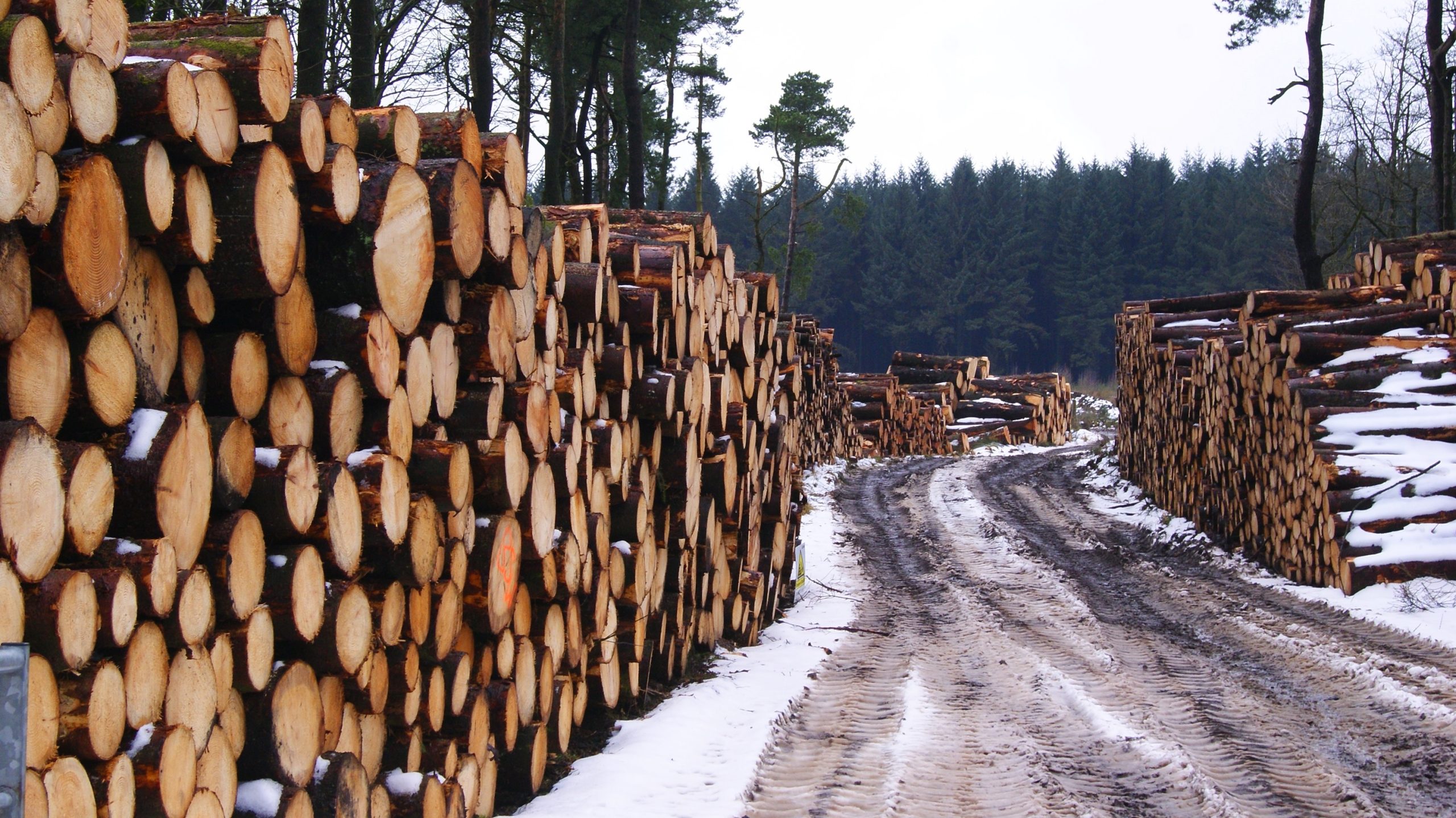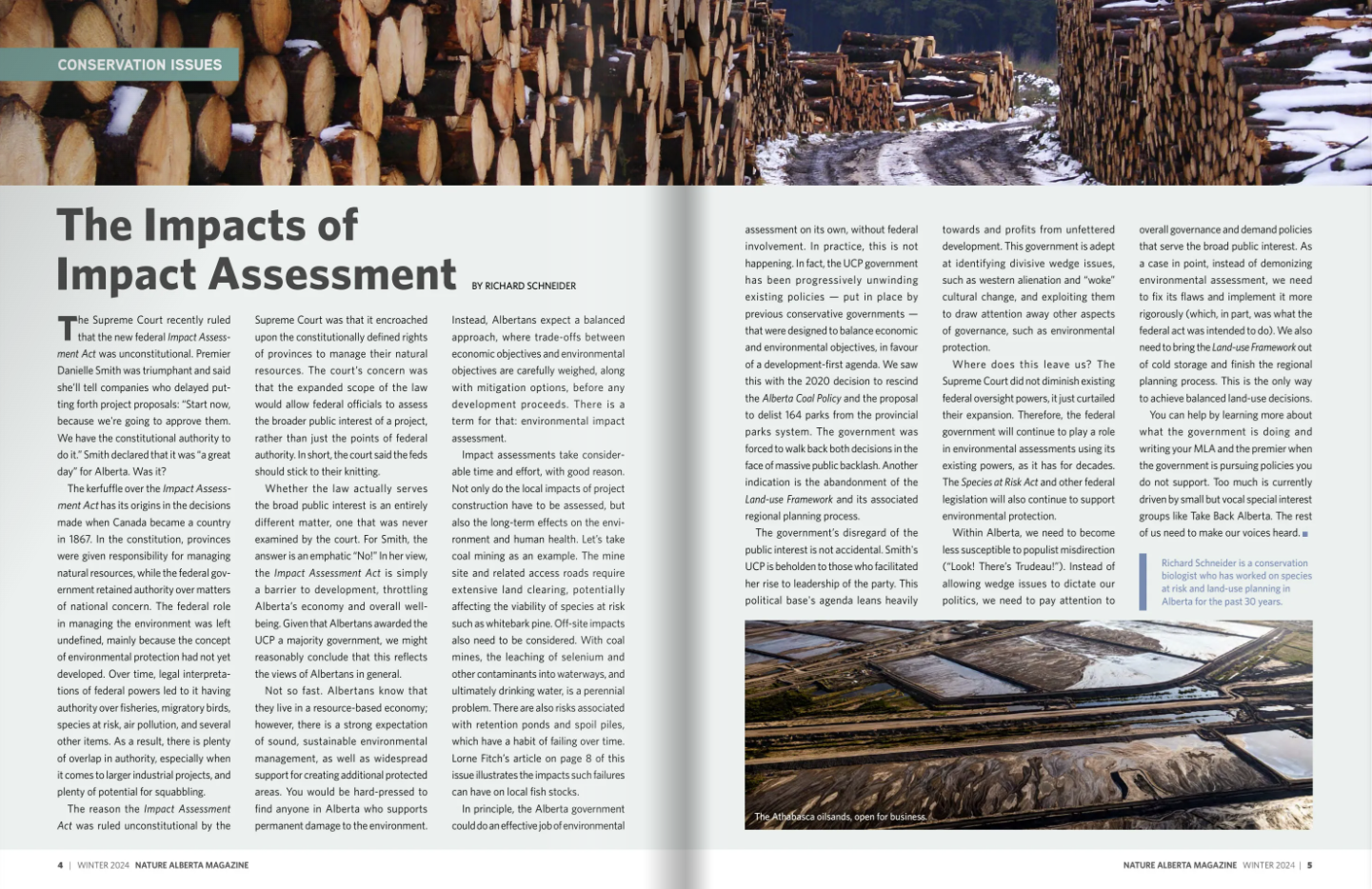The Impacts of Impact Assessment
19 January 2024

BY RICHARD SCHNEIDER
The Supreme Court recently ruled that the new federal Impact Assessment Act was unconstitutional. Premier Danielle Smith was triumphant and said she’ll tell companies who delayed putting forth project proposals: “Start now, because we're going to approve them. We have the constitutional authority to do it.” Smith declared that it was “a great day” for Alberta. Was it?
The kerfuffle over the Impact Assessment Act has its origins in the decisions made when Canada became a country in 1867. In the constitution, provinces were given responsibility for managing natural resources, while the federal government retained authority over matters of national concern. The federal role in managing the environment was left undefined, mainly because the concept of environmental protection had not yet developed. Over time, legal interpretations of federal powers led to it having authority over fisheries, migratory birds, species at risk, air pollution, and several other items. As a result, there is plenty of overlap in authority, especially when it comes to larger industrial projects, and plenty of potential for squabbling.
The reason the Impact Assessment Act was ruled unconstitutional by the Supreme Court was that it encroached upon the constitutionally defined rights of provinces to manage their natural resources. The court’s concern was that the expanded scope of the law would allow federal officials to assess the broader public interest of a project, rather than just the points of federal authority. In short, the court said the feds should stick to their knitting.
Whether the law actually serves the broad public interest is an entirely different matter, one that was never examined by the court. For Smith, the answer is an emphatic “No!” In her view, the Impact Assessment Act is simply a barrier to development, throttling Alberta’s economy and overall well-being. Given that Albertans awarded a majority government, we might reasonably conclude that this reflects the views of Albertans in general.
Not so fast. Albertans know that they live in a resource-based economy; however, there is a strong expectation of sound, sustainable environmental management, as well as widespread support for creating additional protected areas. You would be hard-pressed to find anyone in Alberta who supports permanent damage to the environment. Instead, Albertans expect a balanced approach, where trade-offs between economic objectives and environmental objectives are carefully weighed, along with mitigation options, before any development proceeds. There is a term for that: environmental impact assessment.
Impact assessments take considerable time and effort, with good reason. Not only do the local impacts of project construction have to be assessed, but also the long-term effects on the environment and human health. Let’s take coal mining as an example. The mine site and related access roads require extensive land clearing, potentially affecting the viability of species at risk such as whitebark pine. Off-site impacts also need to be considered. With coal mines, the leaching of selenium and other contaminants into waterways, and ultimately drinking water, is a perennial problem. There are also risks associated with retention ponds and spoil piles, which have a habit of failing over time. Lorne Fitch’s article on page XX of this issue illustrates the impacts such failures can have on local fish stocks.
In principle, the Alberta government could do an effective job of environmental assessment on its own, without federal involvement. In practice, this is not happening. In fact, the current government has been progressively unwinding existing policies that were designed to balance economic and environmental objectives in favour of a development-first agenda. We saw this with the 2020 decision to rescind the Alberta Coal Policy and the proposal to delist 164 parks from the provincial parks system. The government was forced to walk back both decisions in the face of massive public backlash. Another indication is the abandonment of the Land-use Framework and its associated regional planning process.
To understand this disconnect, we have to go back to the 2022 leadership race. Smith was elected to lead the party with just 54% support of members. Her supporters, drawn largely from the former Wildrose Party and its more recent incarnation as the Take Back Alberta movement, are passionate and politically engaged, and they comprise her political base. This small but vocal group is whom she is beholden to and whose agenda she is advancing.
The deeper question here is: if Smith is advancing a narrow and unpopular agenda, why did Albertans vote her in? While there is no simple answer for this, increased political polarization is certainly an important factor. As a populist, Smith is adept at identifying and exploiting wedge issues such as western alienation and “woke” cultural change. Like magicians who misdirect your attention to perform sleight of hand, populists use wedge issues to draw attention away from other aspects of governance, such as environmental protection. This can result in nasty surprises once they are in power.
Another factor is simple inertia. Albertans have been voting conservative for so long that it has become ingrained, despite the fact that the Conservative party of the past no longer exists in Alberta.
Where does this leave us? The Supreme Court did not diminish existing federal oversight powers, it just curtailed their expansion. Therefore, the federal government will continue to play a role in environmental assessments using its existing powers, as it has for decades. The Species at Risk Act and other federal legislation will also continue to support environmental protection.
Within Alberta, we need to become less susceptible to populist misdirection (“Look! There’s Trudeau!”). Instead of allowing wedge issues to dictate our politics, we need to pay attention to overall governance and demand policies that serve the broad public interest. As a case in point, instead of demonizing environmental assessment, we need to fix its flaws and implement it more rigorously (which, in part, was what the federal act was intended to do). We also need to bring the Land-use Framework out of cold storage and finish the regional planning process. This is the only way to achieve balanced land-use decisions.
You can help by learning more about what the government is doing and writing your MLA and the premier when the government is pursuing policies you do not support. Too much is currently driven by small special interest groups like Take Back Alberta. The rest of us need to make our voices heard.
Richard Schneider is a conservation biologist who has worked on species at risk and land-use planning in Alberta for the past 30 years. He is the editor-in-chief of Nature Alberta Magazine.
Read the Original Article for this Post
For a richer reading experience, view this article in the professionally designed online magazine with all images and graphs place.
This article originally ran in the Winter 2024 issue of Nature Alberta Magazine (Vol. 53 | No. 4).


